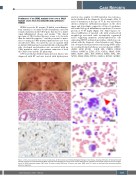Page 225 - 2021_12-Haematologica-web
P. 225
CASE REPORTS
Dominance of an UBA1 mutant clone over a CALR mutant clone: from essential thrombocytemia to VEXAS
VEXAS (vacuoles, E1 enzyme, X-linked, autoinflamma- tory, somatic) is a recently described syndrome caused by somatic mutations in the UBA1 gene that lead to a multi- organ inflammatory disease and anemia.1 The clinical spectrum of UBA1-related diseases seems to be broader than the initial description,2,3 and the potential co-muta- tions occurring in UBA1-mutated patients have not been described yet. Here, we report the case of a patient with an initial CALR-mutated essential thrombocythemia (ET) who developed myelodysplasia cutis associated with an UBA1 mutation, with a concomitant extinction of both the CALR clone and the ET phenotype.
A 65-year-old man without major previous disease was diagnosed with ET and was treated with hydroxyurea
and low dose aspirin. A CALR mutation was retrospec- tively identified in the diagnostic blood sample. After 10 years of treatment, at the age of 75, he was referred for chronic edematous erythematous plaques on the chest, upper and lower limbs, suggestive of Sweet’s syndrome, and a mild biological inflammatory syndrome (C-reactive protein at 30-50 mg/L) (Figure 1A). Skin biopsies evi- denced infiltration of myeloid cells with a histiocytoid morphology associated with incompletely segmented nuclei suggesting immature polymorphonuclear cells expressing CD163 and myeloperoxidase, which was con- sistent with the diagnosis of myelodysplasia cutis4 (Figure 1A). A targeted next generation sequencing (NGS) analy- sis covering 41 myeloid disease associated genes (ASXL1, ASXL2, ATM, BCOR, CALR, CBL, CEBPA, CSF3R, DDX41, DNMT3A, EZH2, FLT3, GATA2, HRAS, IDH1, IDH2, IKZF1, JAK2, KIT, KMT2A, KRAS, MPL, NF1, NPM1, NRAS, PHF6, PTPN11, RAD21, RUNX1, SETBP1,
AB
haematologica | 2021; 106(12)
3245
Figure 1. Skin and sequential bone marrow morphology. (A) Skin lesions and histopathological findings of skin biopsy, showing infiltration of histiocytoid cells staining positively for myeloperoxidase (MPO). (B) May-Grünwald-Giemsa stained bone marrow (BM) aspirate, exhibiting vacuolated myeloid precursors sugges- tive for a VEXAS syndrome (upper, BM1 after 10 years; middle, BM2 after 11 years; and lower, BM3 after 11.5 years of evolution after essential thrombo- cythemia diagnosis).


